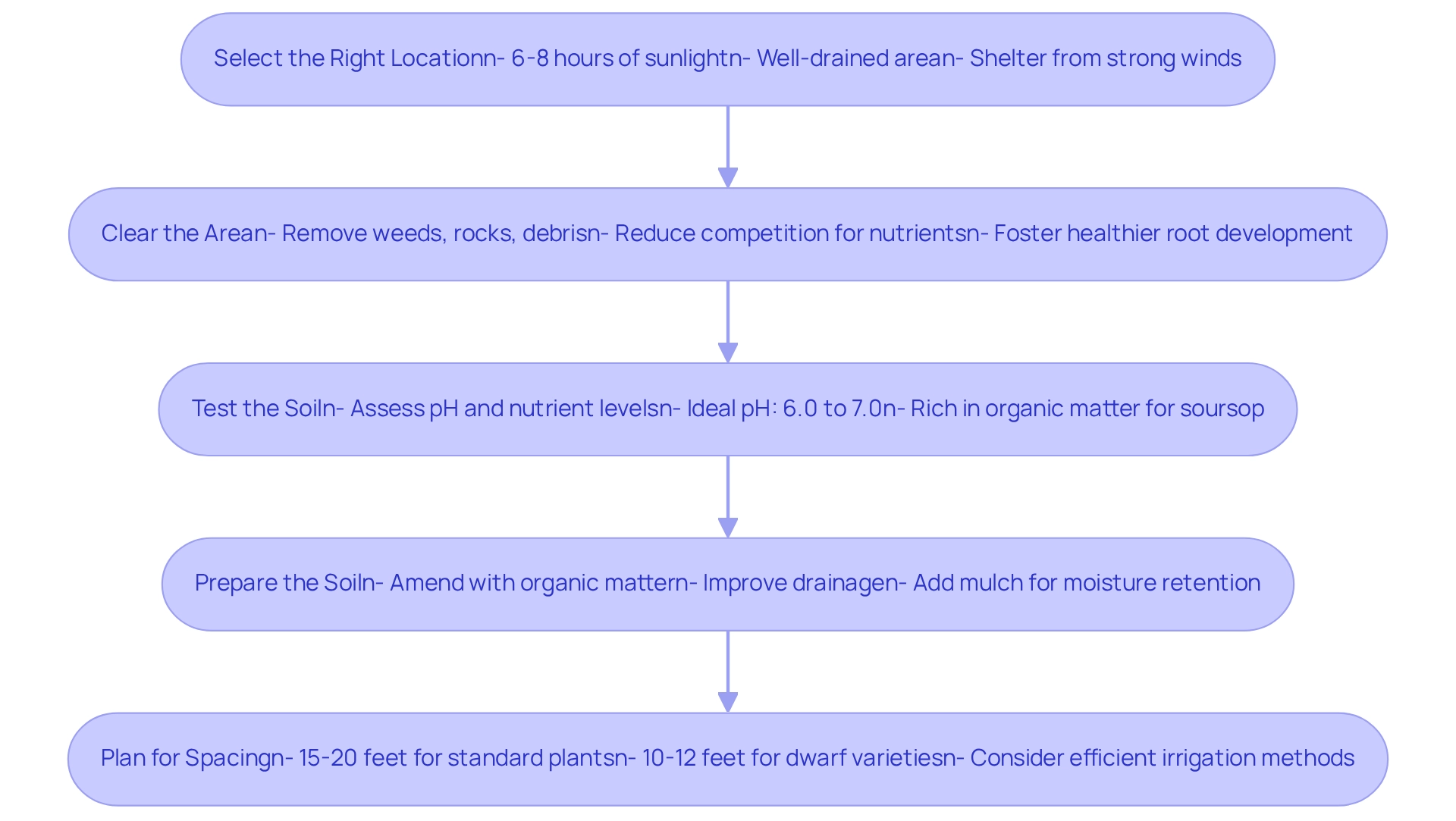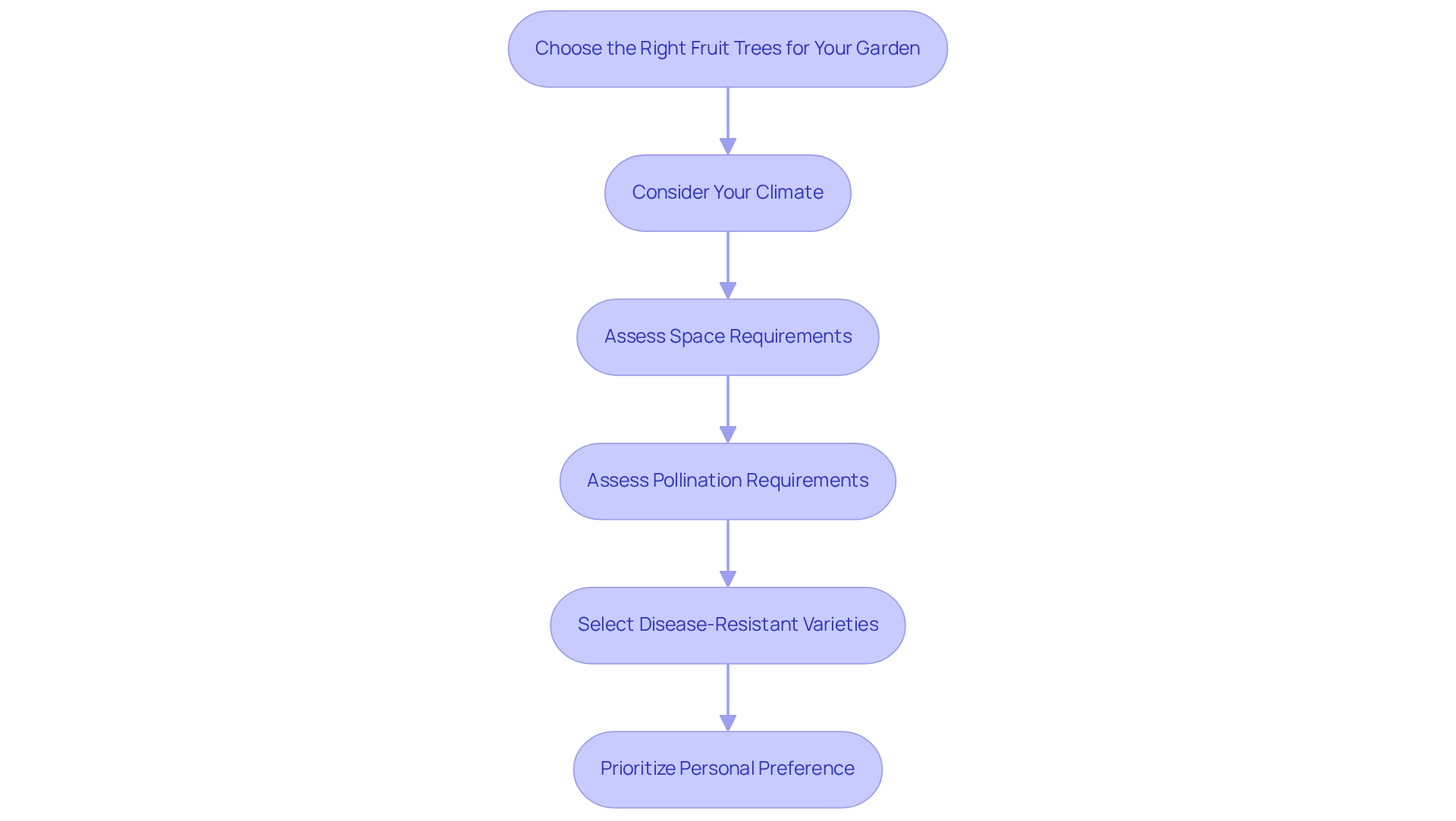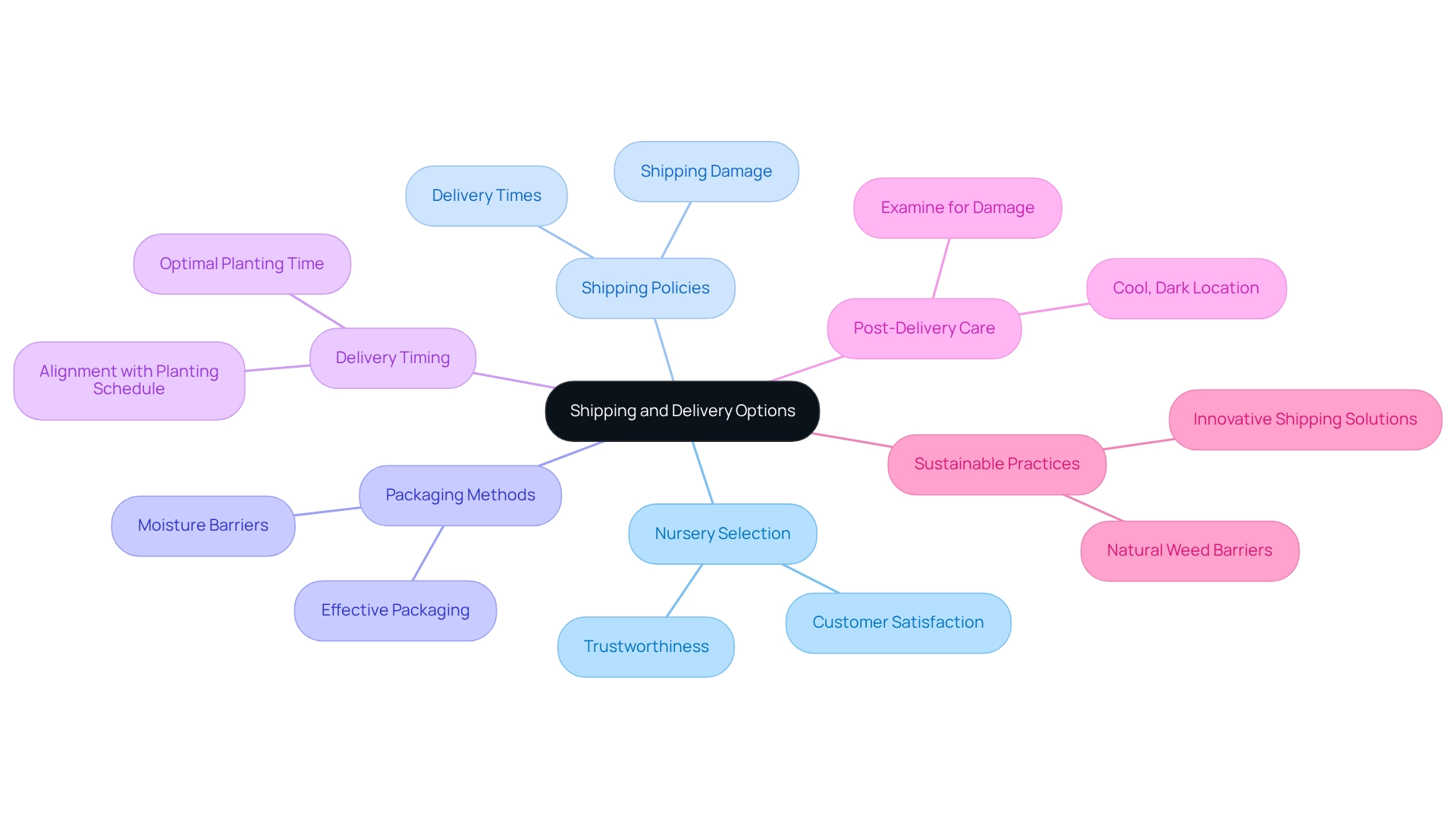
Fruit Tree Delivery: Steps for Successful Planting and Care
Share
This article lovingly guides you through the essential steps for successfully planting and caring for fruit trees. It begins by emphasizing the importance of site preparation, tree selection, and post-delivery care—key elements that can make your gardening journey a rewarding experience. Have you ever wondered about the best conditions for your trees? Factors such as sunlight, soil quality, and proper spacing play a crucial role in ensuring your trees thrive.
As you embark on this journey, remember that regular monitoring and organic pest control are vital to fostering healthy growth and fruitful yields. By nurturing your trees with care, you're not just planting; you're cultivating a vibrant ecosystem that will yield delicious fruits for you and your loved ones. So, let's take these steps together, ensuring that each tree you plant becomes a source of joy and nourishment.
🌱 Ready to start your garden transformation? Explore Everglades Farm’s tropical fruit tree collection and choose the perfect trees for your space—we’ll deliver them straight to your door.

Introduction
Creating a thriving garden filled with delicious tropical fruit trees is a rewarding endeavor that begins long before the first planting. Have you ever dreamed of stepping into your own lush oasis? It all starts with selecting the perfect location that basks in sunlight and choosing the right varieties suited for your specific climate. Every decision you make plays a pivotal role in ensuring a fruitful harvest.
Understanding the nuances of soil preparation, spacing, and even shipping logistics can significantly impact the success of your plants. It might seem overwhelming, but with careful planning and the right knowledge, you can transform your outdoor space into a haven of flavor and abundance. Remember, nurturing these trees is as enjoyable as the fruits they bear, and every step you take is a step towards that dream garden.
Draft
1. Prepare Your Space for Delivery
-
Select the Right Location: It's important to choose a spot that receives at least 6-8 hours of sunlight each day, as most plants truly thrive in full sun. This ideal sunlight exposure is essential for crop production, enabling your plants to flourish. Make sure the area is well-drained to prevent waterlogging, which can severely damage the roots and hinder their development. For passion fruit and soursop plants, selecting a site that offers shelter from strong winds can enhance their growth and fruit production.
-
Clear the Area: Take a moment to remove any weeds, rocks, or debris from your planting site. This simple act not only reduces competition for nutrients and water but also fosters healthier development for your plants. By clearing the area, you create a nurturing environment for the roots to establish themselves effectively.
Test the Soil: Conducting a soil test is a crucial step to assess pH and nutrient levels. Fruit plants typically prefer slightly acidic to neutral soil, with an ideal pH range of 6.0 to 7.0, ensuring they have the right conditions for vigorous growth. For soursop plants, well-drained soil rich in organic matter is particularly beneficial.
-
Prepare the Soil: Amending the soil with organic matter, such as compost, enhances fertility and improves drainage. This preparation is vital, as low light conditions can diminish bloom production, leading to fewer yields. Well-prepared soil is essential for your plants' well-being, promoting better root growth and nutrient absorption. For passion fruit vines, adding mulch can help retain moisture and suppress weeds.
- Plan for Spacing: It's essential to ensure adequate spacing between plants based on their mature size. For standard plants, allowing 15-20 feet between each is ideal, while dwarf varieties need about 10-12 feet. Proper spacing is crucial for air circulation and sunlight exposure, both vital for crop production. Additionally, consider efficient irrigation methods, such as low flow emitters and microsprinklers, to ensure your plants receive sufficient water during the growing season, further enhancing their health and productivity.

2. Choose the Right Fruit Trees for Your Garden
- Consider Your Climate: Understanding your USDA hardiness zone is essential when choosing edible plants. Tropical varieties like mangoes and avocados thrive in warmer climates, making them perfect for regions with mild winters and plenty of sunlight. Everglades Farm's Fast-Growing Plants collection features a delightful range of tropical-bearing plants that thrive in these conditions, ensuring a bountiful harvest with our fruit tree delivery.
- Assess Space Requirements: Take a moment to evaluate the space available in your garden. Dwarf plants from Everglades Farm are ideal for smaller areas, providing the same delicious produce as their larger counterparts but in a more convenient size. On the other hand, typical plants require more room to grow and expand, so it’s crucial to choose the right variety that fits your garden's design.
- Assess Pollination Requirements: Many fruit-bearing plants depend on cross-pollination to produce fruit. It's important to check if your chosen varieties need a compatible partner nearby to ensure a fruitful harvest. Supporting pollinator health is vital for maintaining fruit yields, especially in our changing environment. Everglades Farm's Fast-Growing Plants collection features varieties known for their compatibility with others, enhancing your chances of a plentiful harvest.
- Select Disease-Resistant Varieties: Choose trees that show resistance to common pests and diseases in your area. This not only promotes healthier growth but also reduces the need for chemical interventions, aligning with sustainable gardening practices. Everglades Farm offers professional-grade fertilizers that can further enhance your plants' resilience, ensuring they thrive in your garden.
- Prioritize Personal Preference: Ultimately, select produce that you and your family love. As James Boswell wisely noted, "In an orchard there should be enough to eat, enough to lay up, enough to be stolen, and enough to rot on the ground." This personal connection to your garden will enrich your experience and satisfaction with the harvest.
In 2025, the finest tropical plants for warm climates include varieties that are not only delicious but also resilient against shifting environmental conditions. As climate change continues to impact our gardening practices, ongoing discussions about selecting the right plants become increasingly important. Successful examples of dwarf plant cultivation show that even in limited spaces, you can achieve abundant harvests. This reinforces the idea that thoughtful choices based on your climate and space can lead to productive outcomes. Explore Everglades Farm's Fast-Growing Trees collection for quick-yield tropical greenery and convenient fruit tree delivery to transform your garden into a thriving oasis.

🍋 Need help picking the right tree for your space or climate? Check out our best-sellers or learn more about how Everglades Farm ensures quality delivery from farm to your garden.
3. Understand Shipping and Delivery Options
Selecting a trustworthy nursery is essential for a successful planting experience. At Everglades Farm, we pride ourselves on our commitment to providing healthy tropical fruit plants through our fruit tree delivery directly to you, ensuring a positive gardening journey. With our seamless online ordering process, you can effortlessly add your desired plants to your cart and check out with confidence, knowing that quality and customer satisfaction, particularly regarding fruit tree delivery, are our top priorities.
It's important to thoroughly examine the nursery's shipping policies, including delivery times and packaging methods. Effective packaging is crucial to safeguarding your plants during transit. Here at Everglades Farm, we utilize moisture barriers to maintain soil integrity, minimizing stress on your cherished vegetation, and timing your fruit tree delivery to align with your planting schedule is key. Early spring is often the ideal time to plant fruit plants, allowing them to establish roots before the heat of summer sets in.
Upon receiving your plants, take a moment to examine them for any signs of damage or stress. Healthy roots should feel moist, indicating they were well cared for during shipping. A good rule of thumb is to water your plants a day before shipping, allowing excess water to drain. This ensures they arrive in optimal condition. As Shankar Godavarti, a Global Product, Quality & Strategy Executive, wisely notes, 'the burgeoning e-commerce sector provides unparalleled convenience for consumers, while innovative logistics and packaging solutions are mitigating the challenges associated with transporting live plants.'
If prompt planting isn't feasible, consider keeping your plants in a cool, dark location, ensuring the roots remain moist until you're ready to plant. This practice helps preserve their vitality, preparing them for fruitful growth in your garden.
Moreover, reflect on the trends in sustainable cultivation methods. For instance, Perfect Plants' innovative approach to shipping incorporates ryegrass as a natural weed barrier. Understanding these shipping and delivery choices, particularly fruit tree delivery, not only enhances your horticultural experience but also contributes to the overall success of growing tropical trees at home. Statistics on customer satisfaction with online nurseries and insights on shipping damage during transit further underscore the importance of selecting a reliable nursery for your gardening needs.

4. Care for Your Trees After Delivery
As you embark on your gardening journey, it's essential to conduct regular inspections for signs of pests or diseases. If you're growing passion fruit, be especially vigilant against passion vine hoppers, as these pests can cause significant damage to your vines. Consider implementing organic pest control methods—such as introducing beneficial insects or using insecticidal soap—to protect your plants while honoring the environment.
For those nurturing soursop plants, selecting the right planting spot is crucial for promoting healthy growth. Additionally, creating a habitat that deters rodents can safeguard your trees from unwanted damage. As Kathy Zuzek, a former Extension educator, wisely notes, "Create habitat for rodents that chew bark and girdle trunks and stems." This practice not only protects your plants but also fosters a healthier garden ecosystem.
Remember, every step you take in caring for your garden contributes to its overall well-being. By being proactive and nurturing your plants, you're cultivating a thriving environment that reflects your dedication and love for gardening.

Conclusion
Transforming a garden into a thriving oasis filled with tropical fruit trees is a journey that requires thoughtful planning and execution. By selecting the right location that bathes in sunlight, clearing away debris, and preparing the soil, you lay a strong foundation for successful tree growth. Understanding the specific needs of each fruit tree, including their spacing and soil requirements, can significantly enhance their chances of thriving and delivering a bountiful harvest.
Choosing the right varieties of fruit trees that suit your local climate and personal preferences is equally vital. By considering factors such as pollination needs and disease resistance, you can ensure a fruitful yield while minimizing the use of chemicals. The diversity of options available, including dwarf varieties for compact spaces, means that anyone can cultivate delicious fruits, regardless of garden size.
Moreover, understanding shipping and delivery logistics is essential for maintaining plant health from the nursery to your garden. Selecting a reputable nursery that prioritizes quality and customer satisfaction can make a significant difference in your gardening experience. Proper inspection upon delivery and timely planting will further enhance the likelihood of successful growth.
Ultimately, nurturing tropical fruit trees is a rewarding journey that combines art, science, and personal enjoyment. With the right knowledge and dedication, you can transform your outdoor space into a lush, productive garden that yields delicious fruits for years to come. Investing time and effort in these initial stages will pay off, creating a vibrant haven that reflects your dream of a personal paradise. So, let’s embark on this beautiful journey together, nurturing our gardens and watching them flourish!
🍊 Let’s Grow Something Delicious Together
You don’t have to figure it all out alone—Everglades Farm is here to help with expert-picked trees, detailed care instructions, and fast shipping right from Florida.
Whether you're dreaming of mangoes, passion fruit, or soursop, your backyard paradise starts now.

Frequently Asked Questions
What factors should I consider when selecting a location for planting?
Choose a location that receives at least 6-8 hours of sunlight daily, has well-drained soil to prevent waterlogging, and offers shelter from strong winds for plants like passion fruit and soursop.
Why is it important to clear the planting area?
Clearing the area of weeds, rocks, and debris reduces competition for nutrients and water, creating a healthier environment for plant roots to establish.
How do I test the soil before planting?
Conduct a soil test to assess pH and nutrient levels. Fruit plants prefer slightly acidic to neutral soil, ideally with a pH range of 6.0 to 7.0.
What should I do to prepare the soil for planting?
Amend the soil with organic matter, such as compost, to enhance fertility and improve drainage. This preparation is crucial for better root growth and nutrient absorption.
How should I plan for spacing between plants?
Ensure adequate spacing based on the mature size of the plants: 15-20 feet for standard varieties and 10-12 feet for dwarf varieties. Proper spacing is essential for air circulation and sunlight exposure.
What irrigation methods should I consider for my plants?
Consider using efficient irrigation methods such as low flow emitters and microsprinklers to ensure your plants receive sufficient water during the growing season.

